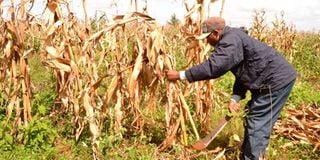Optimising profits through Good Agricultural Practices

A worker harvests maize in Nyahururu, laikipia County. Crops residues have various uses that include fertiliser, bio-fuel, livestock feed and it should not be burnt because it has long-term effects on climate change.
Crop residues (CRs) are the plant remains after harvesting of crop intended for food, feed and or fiber. The materials include stalks, tops, leaves, and shoots of tuber, oil, sugar and vegetable crops and fruits. In mid 1990, the global CRs was estimated at 3,750 x 106 t, which was more than 1,000 x106t of the dry matter of the harvested cereals, sugar crops, roots/tubers, vegetables, fruits, legumes, oil crops and other crops. In Kenya, there is an estimated 13,913,223t of CRs produced annually.
Improper utilisation of these residues though burning, plus other improper uses has resulted in serious land and soil degradation, environmental pollution and lowered profits. Understanding the many and profitable uses of CRs will therefore lead to informed choices that will avoid the observed catastrophes.
CRs
Many countries do not keep records on the quantities of CRs they produce annually. However, estimation is possible using the harvest index (HI).This is the ratio of crop yield to the crop’s total aboveground plant material.
The average HI is about 0.42 and specific ones includes cereals, roots/tubers (0.40); sugar crops (0.56); vegetables/fruits (0.38); legumes (0.49); oil crops (0.52) and others (0.28). Crops residues have various uses that include fertiliser, bio-fuel, livestock feed/beddings, building material, mushroom growing, and pulp and chemicals among others.
The uses have thus converted the agricultural waste that many have been disposing off through burning into a valuable resource. To optimise on direct or indirect profits, there is need to balance on the uses.
Fertiliser
CRs left on the farm after harvesting act as mulch which controls water and soil erosion and retains soil moisture leading to subsequent bumper harvests. Further, degradation of these materials releases the bound nutrients in them like nitrogen and carbon which are the constituents of fertilisers.
CRs also improve soil aeration by promoting free exchange of gasses between the soil and the atmosphere. The fertiliser equivalent of residues produced in India for example is about 760,000 tonne.
The presence of the residues also physically prevent emergence of weeds in addition to release of some chemicals that inhibit weed growth.
This minimises weed/crop competition resulting in enhanced crop production. However, since CRs are also used as animal feeds especially during the dry seasons of the year when there is feed scarcity, there is need to use some of it as animal feeds.
Bio-fuel
The average energy content of dry residues is about 18MJ/kg(3,400kcal/kg) so in countries like Kenya where about 70 per cent of the households use wood fuel (firewood and charcoal) for cooking, CRs can supplement these sources. However, for extensive use as a fuel source, there is need to add value to the residues especially the density to form fuel briquettes which can be achieved through addition of binders such as clay, cow dung, molasses etc.
Fermentation of CRs with animal waste produces biogas which is another way of complementing household energy needs but this might not be practical due to the bulkiness and low energy content of the material.
Livestock feed
CRs can be fed to animals by grazing them on the stubble that is left behind after harvesting or by collecting and transporting the material to a central place like the grass fields or animal pens. The material is best for ruminant animals that have a fore-stomach.
These include cattle, sheep and goats. This is because the bacterial in the fore-stomachs of these animals is able to break down cellulose and other fibrous materials, thus releasing nutrients in CRs. Chopping, adding alkali, urea, molasses, protein rich fodder and others are ways of adding value to CRs earmarked as animal feeds.
Feeding the CRs to animals has the potential to produce triple benefits in that there will be an increase in animal production and the animal waste can be used to produce biogas for household energy and at the same time produce slurry which is a better fertiliser than the composted fertiliser. Slurry too will increase crop production.
Livestock bedding
In addition to keeping the animals warm and dry, cereal straws used as livestock bedding material which is later disposed-off in farms where they act as an organic fertiliser.
Mushroom growing
Wheat and rice straws are ideal substrates for cultivation the two most grown mushrooms (the white button and the straw mushroom). This is therefore a way of nutrient recycling and conversion of inedible matter into foodstuff of high quality.
Why you should not burn CRs
Burning CRs has the long term effect of climate change due to the resulting smoke that has the carbon dioxide and methane greenhouse gasses which cause global warming and climate change.
It also leads to accelerated loss of soil carbon and killing of beneficial soil micro-organisms. So if you must burn CRs, let them be fuel not fire. In maize harvesting, the weight of the dry grains is about 40 per cent of the plant, the rest is CR





